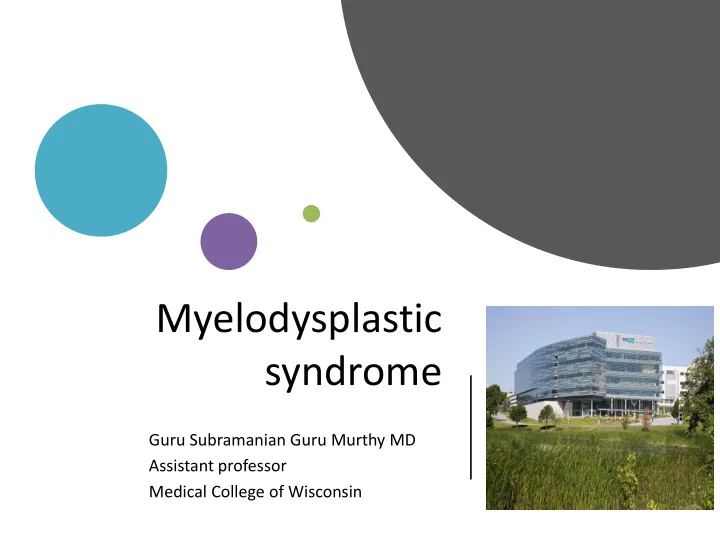

Myelodysplastic syndrome Guru Subramanian Guru Murthy MD Assistant professor Medical College of Wisconsin
MDS Clonal hematopoietic disorder - • multilineage hematopoietic progenitor Ineffective hematopoiesis • Dysplasia • Peripheral cytopenias and bone • marrow failure Risk of transformation to AML in • RBC – Carries oxygen in blood 35 to 40% WBC – Fights against infection Platelets – prevents bleeding
How common is MDS ? : Zeidan AM et al. Blood Rev 2019
Genetic mutations How does it start ? Series of genetic events over time • Exposure to environmental • factors Genetic predisposition • Prior chemotherapy or • radiotherapy Epigenetic abnormalities • Abnormal DNA repair • Decreased cell death (apoptosis) • Telomerase dysfunction • Overlaps with other disorders • such as aplastic anemia, paroxysmal nocturnal hemoglobinuria Issa J. Blood 2013 Young NS. Ann Intern Med. 2002
Symptoms and signs Asymptomatic • Fatigue • Easy bleeding • Recurrent infections • Fever • Night sweats • Anemia Leukopenia Thrombocytopenia -Tiredness -Increased risk of - Increased bleeding -Fatigue infections -Shortness of breath
DIAGNOSIS History and physical exam • – symptoms, medications, transfusions Cytogenetics FISH Peripheral blood counts • and smear review Bone marrow biopsy and • aspiration - Bone marrow blasts % - Cytogenetics/FISH - Iron stain - Reticulin stain
Cytopenia + >10% dysplastic cells in 1 or more lineages, or MDS 5-19% blasts, or criteria MDS chromosomal abnormality or Specific MDS mutation
Vitamin B12/folate deficiency HIV /viral infection Copper deficiency Conditions Alcohol abuse that mimic MDS Medications (methotrexate, azathioprine, recent chemotherapy) Congenital syndromes (Fanconi anemia) Autoimmune conditions (SLE, ITP)
How is MDS treated ?
Risk stratification Establishing treatment goals Principles of MDS Disease specific agents management Supportive measures Allogeneic stem cell transplantation
IPSS R-IPSS RISK WPSS STRATIFICATION Low risk IPSS Approaches to include genomic features
IPSS- International prognostic scoring system Greenberg P et al. Blood 1997 NCCN guidelines MDS 2019
Revised IPSS Greenberg P et al. Blood 2012 NCCN guidelines MDS 2019
Low risk: IPSS low, intermediate-1 Revised IPSS – very low, low, intermediate Survival – 3-8 years without therapy Focus to improve marrow function, minimize complications and improve QOL High risk TREATMENT IPSS intermediate-2, high Revised IPSS – high, very high OUTLINE Survival - <2 years without therapy, high risk of AML transformation Focus to eradicate the disease, reduce AML transformation, improve survival and QOL Therapy related Aggressive subtype with poor response to therapy Usually considered for allogeneic stem cell transplantation
Low risk disease Observation • Del5q – Lenalidomide • Serum EPO ≤500 with • anemia – Erythropoietin or darbepoetin/G-CSF Immunosuppressive • therapy – ATG/cyclosporine NCCN guidelines MDS 2019
Lenalidomide Immunomodulatory • agent shown to have activity in patients with del5q MDS (and some patients without del5q) Dose: 10mg once • daily, oral List et al. NEJM 2006
ESA/G-CSF Erythropoietin-alfa or • Darbepoetin Low risk MDS with • anemia Given as subcutaneous • injection Can be given with or • without G-CSF Response rate 40-60% • Target Hb of 10-12 • Hellström-Lindberg E et al. Br J Haematol 2003
Immunosuppressive therapy ATG, cyclosporine Hypoplastic bone • marrow Normal cytogenetics • Low risk disease • PNH clones • HLA-DR15 • Young (age <60) • Stahl M et al. Blood Adv 2018
RBC transfusion for anemia and platelet transfusion for thrombocytopenia Higher RBC transfusion burden increases the risk of complications from iron overload Transfusions Iron chelation: Deferoxamine or deferasirox and iron Patients who have received or are anticipated chelation to receive greater than 20 RBC transfusions Patients for whom ongoing RBC transfusions are anticipated Patients with serum ferritin levels greater than 2500 ng/mL NCCN guidelines MDS 2019
High risk disease Hypomethylating • agents – Decitabine or Azacitidine Allogeneic stem cell • transplantation NCCN guidelines MDS 2019
Azacitidine Hypomethylating • agents Given SC or IV, • typically 7 days Usually takes upto 6 • cycles to see response OS benefit: 9.4 mon Time to AML: 17.8 vs. 11.5 mos Alternative dosing • TI: 45% vs. 11% schedules have been ORR 50%, CR 17% studied Feneaux et al. Lancet Oncol 2009
Decitabine Hypomethylating agent • Given as IV – typically • 20mg/m2 for 5 days Can take 4 cycles to • have response Median time to AML - • 4.3 months greater 17% CR+PR • Kantarjian et al. Cancer 2006
Allogeneic stem cell transplant Curative option • Often limited by factors • such as patient fitness, comorbid conditions and availability of donor Cures MDS in about 30- • 40% of patients Risk of death from • Infections GVHD Disease relapse transplant is 15-20% Risk of relapse 35-50% •
Unmet Disease Disease relapse Disease progression after after allogeneic progression after decitabine or stem cell need… lenalidomide azacitidine transplantation
POTENTIAL NEW AGENTS Aleshin et al. Blood Adv 2018
Luspatarcept First-in-class erythroid maturation agent - Recent clinical trial showed significant benefit in terms of RBC transfusion independence - 37.9% achieved RBC-TI for ≥ 8 weeks - Low risk disease - Not FDA approved yet List A et al. ASH 2018
Allo vs Hypomethylating/Best Supportive Care in MDS (BMT CTN 1102) Hypomethylating Properties of Freeze-dried Black Raspberries (BRB) in Patients With Myelodysplastic Syndrome or Myelodysplastic Few Syndrome/Myeloproliferative Neoplasm trials.. A Trial to Evaluate the Potential Impact of Renal Impairment on the Pharmacokinetics and Safety of CPX-351 Safety Study of MGD006 in Relapsed/Refractory Acute Myeloid Leukemia (AML) or Intermediate-2/High Risk MDS
QUESTIONS?
Recommend
More recommend